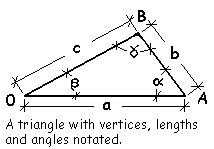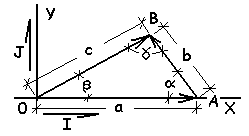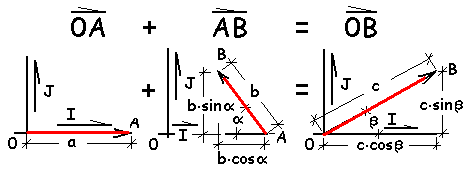Vector Proof of Trigonometry Laws
A typical planar triangle is shown below. The triangle vertices, lengths of sides, and angles are identified by notation.

We choose to define a vector space to be the plane of the triangle. We name the two-dimensional space 0XY. We place the origin of the space at the A0B vertice of the triangle and we align its X-axis along the triangle side, 0A. The Y-axis passes through the origin, orthogonal to the X-axis. To be completely defined a vector space must have a unit vector basis. We choose the uppercase letters, I and J, to represent unit vector directions for the X and Y coordinates, respectively.

Next we state something we believe to be so completely true that you and I can accept its truth axiomatically. (The simplest axiomatic truth is: "We exist." The proof goes: "I exist." No argument about that. I see you and you say, "I exist." Conclusion: "We exist." It is an axiomatic truth that we exist.
So for this triangle it is axiomatically true for the vectors of its sides:
0A + AB = 0B
(As an aside, note that 0A + 0B = AB is false, that is, axiomatically wrong).
The sketch below shows how these vectors are written in component form.

From the figures we see:
a I - b cosα I + b sinα J = c cosβ I + c sinβ J
Equivalently,
(a - b cosα) I + b sinα J = c cosβ I + c sinβ J
From the J component we have, b sinα = c sinβ which divided by bc yields:
Law of Sines: (sinα)/c = (sinβ)/b
Next we take the I component relation; ( a - b cosα) = ( c cos β) and square it to obtain (i):
(i) a2 - 2 a b (cosα) + b2 (cosα)2 = ( c cosβ)2
The J component relation is (b sinα)2= (c sinβ)2. We square this expression also to obtain:
(ii) (b sinα)2= (c sinβ)2
Next expression (i) and (ii) are added:
[a2 - 2 a b (cosα) + b2 (cosα)2] + (b sinα)2 = c2(cos2β) + sin2β)
The component relations, J are relations, square each of them and add their squares:
I: ( a - b cosα)2 = ( c cosβ)2 and J: (b sinα)2= (c sinβ)2
a2 - 2 a b (cosα) + b2 (cosα)2 = c2 (sinβ)2
b2 (sinα)2 = c2 (sinβ)2.
With a bit of algebra we have:
Law of Cosines: a2 - 2 a b (cosα) + b2 = c2